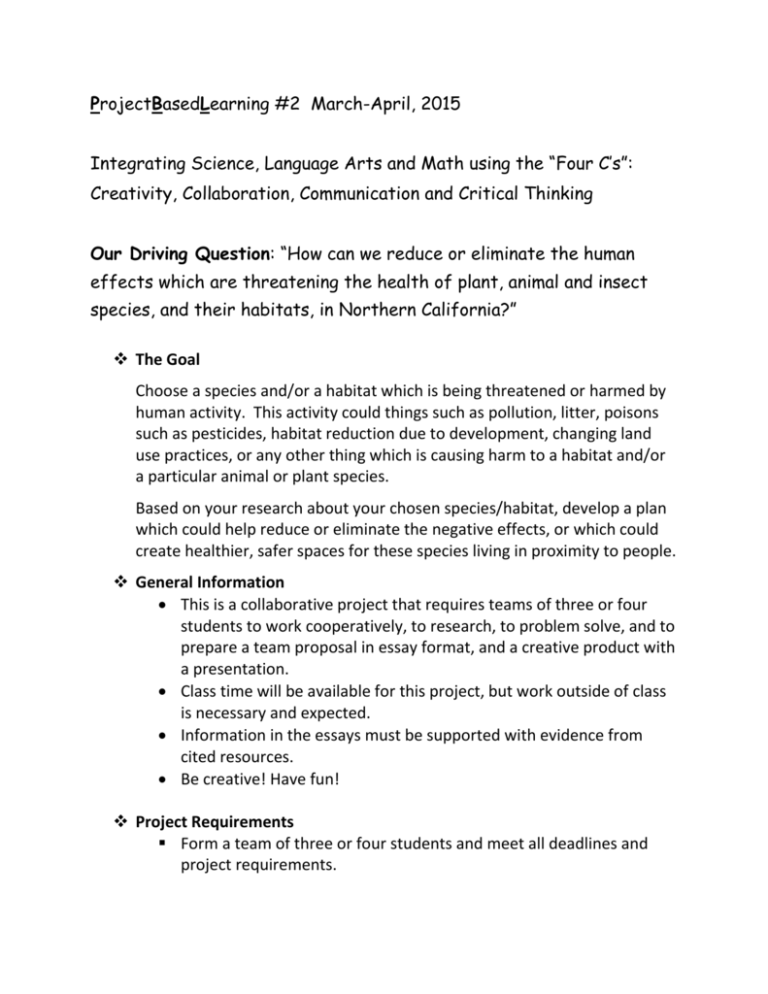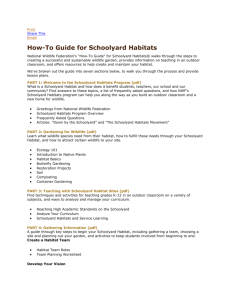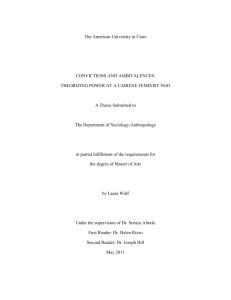PBL Overview and Websites
advertisement

ProjectBasedLearning #2 March-April, 2015 Integrating Science, Language Arts and Math using the “Four C’s”: Creativity, Collaboration, Communication and Critical Thinking Our Driving Question: “How can we reduce or eliminate the human effects which are threatening the health of plant, animal and insect species, and their habitats, in Northern California?” The Goal Choose a species and/or a habitat which is being threatened or harmed by human activity. This activity could things such as pollution, litter, poisons such as pesticides, habitat reduction due to development, changing land use practices, or any other thing which is causing harm to a habitat and/or a particular animal or plant species. Based on your research about your chosen species/habitat, develop a plan which could help reduce or eliminate the negative effects, or which could create healthier, safer spaces for these species living in proximity to people. General Information This is a collaborative project that requires teams of three or four students to work cooperatively, to research, to problem solve, and to prepare a team proposal in essay format, and a creative product with a presentation. Class time will be available for this project, but work outside of class is necessary and expected. Information in the essays must be supported with evidence from cited resources. Be creative! Have fun! Project Requirements Form a team of three or four students and meet all deadlines and project requirements. Within your team, choose your species and or habitat, and research the general information and status of your chosen s/h. To research this topic thoroughly you will need to learn about the following: Find out what your species/habitat needs to function in a healthy way, and determine what things people are doing that are causing harm. What is the previous condition of your s/h (before human activity began harming it) What is the current condition of your s/h? What is the human activity that is specifically harming your s/h? What potential harm might people do? What other factors are affecting your s/h- drought? Increased predators? Reduced food sources? Or??? Then come up with a plan! What will help your species or habitat regain a healthy status OR be able to maintain a healthy existence within an urban/suburban environment (if living close to people.) What options are currently available? What could you do or suggest that would help your s/h status? Write a research essay: o Paragraph 1:introduce your species or habitat. How is your species/habitat important to the “big picture” of interdependence and environmental health? Be clear - give an overview of the problem and the possible ways we can help. This is introductory- you don’t need details in this paragraph, just let the reader know what the body of your essay will contain. o Paragraph 2: provide details about your species/habitat; what it needs for health and sustainability. Provide details about what is causing it harm or threatening its existence/health. This is based in research and must be supported accordingly. o Paragraph 3: clearly describe your plan or suggestions for actions to improve the situation for your species/habitat. What will make things better? What actions can be taken which are feasible and realistic? Be sure this tells what impact your ideas will have and how it will help. o Paragraph 4: Restate the situation and what will help. This should include a restatement of the species/habitat’s role in its ecosystem. This may include a call to action. o The essay is based on evidence and data from your research. (Cite your sources: websites, books, people, etc.) Prepare a class presentation to show a panel of your proposed plans of action. You can create a video commercial, a poster, Public Service Announcement, jingle/song, informational power point, or something else creative and persuasive! You will present your proposed solution to a panel of adults from the community at the end of this project. You should also include research regarding approximate costs, and available sources of any materials that may be needed. Possible focus targets for your project: Any endangered or threatened animal species. Any threatened or diminishing habitat, especially those which are critical to the health of animals living there. Any specific pollution source which has widespread impacts on habitats or species. Any groups of animals or plants which rely on each other for subsistence. Pollinators and what effects may be harming them. The role of increased or decreased species within a food chain. Handy Websites: https://www.wildlife.ca.gov/ click on Conservation tab- there is a LOT of information and potential ideas! http://www.savetheredwoods.org Click on the “Redwoods” tab. This site has lots of good basic information about the redwood habitats and the species living in them. The site is broken up into redwood habitats that http://www.fs.fed.us/wildflowers/pollinators/documents/AttractingPollinatorsV5 .pdf This site has info on what native pollinators need and ways to attract them. http://www.nwf.org/ This is the National Wildlife Federation website. If you click on the wildlife tab, then “search” California Species (upper right area of page), and lots of good ideas come up to look into. monarchs/?s_subsrc=Web_Biggie__Home_SavetheMonarch This National Wildlife Federation blog has info on the monarch butterfly http://www.nwf.org/How-to-Help/Garden-forWildlife.aspx?campaignid=WH14F1DSCXX&s_subsrc=Web_Navigation_CWH_Wild life This NWF site has info on gardening for wildlife http://www.nwf.org/wildlife/wildlife-library/amphibians-reptiles-andfish/california-red-legged-frog.aspx This is another NWF site that talks about a threatened species and provides information about the factors that are threatening the red-legged frog; this article may provide ideas about possible threats to other species.










